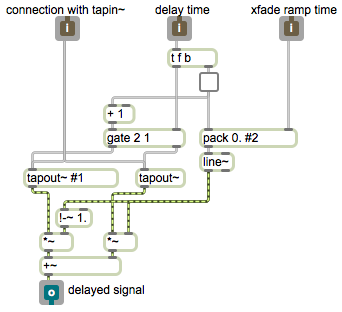If we want to use the delay crossfading technique shown in the above example for multiple different delays of the same sound, the simplest solution is just to make multiple copies of that abstraction and send the same audio signal to each one. However, that’s a bit inefficient in terms of memory usage because each subpatch would have its own tapin~ object, each of which would be containing the same audio data.
The way that tapin~ and tapout~ communicate is that when audio is turned on tapin~ sends out a ‘tapconnect’ message. When tapout~ receives a ‘tapconnect’ message it refers to the memory in the tapin~ object above it. So we really could modify our delay crossfade abstraction so that, instead of receiving an audio signal in its left inlet, it receives the message ‘tapconnect’. That way, multiple copies of the abstraction could all refer to the same tapin~ object in their parent patch.
So this example shows a modification of the delay crossfading abstraction, in which the tapin~ object has been removed, and in which the left inlet expects a ‘tapconnect’ message instead of an audio signal. It will refer to a tapin~ object in the parent patch. You can save this abstraction with a different name, such as tapoutxfade~.

